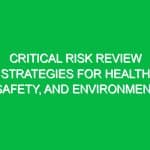Introduction
In today’s world, where Safety and environmental Standards are paramount, risk management samples play a crucial role in the Health, Safety, and Environment (HSE) domain. Understanding and implementing an effective risk management sample is not just a regulatory requirement but a moral obligation. This article delves into the intricacies of risk management samples specific to HSE, illustrating their importance and providing actionable insights for organizations striving to safeguard their future.
Risk management refers to the systematic process of identifying, assessing, and mitigating risks that could potentially harm individuals, property, or the environment. In the HSE context, this encompasses a wide range of factors, including Workplace Safety, environmental protection, and the well-being of employees. A well-structured risk management sample serves as a blueprint for organizations to develop their own risk management strategies, tailored to their unique operational landscapes.
Understanding Risk Management in HSE
Risk management within the HSE framework involves several key components that collectively ensure a safe and compliant workplace. A comprehensive risk management sample includes the following elements:
- Risk Identification: This involves recognizing potential Hazards that could cause harm. Hazards may include physical, chemical, biological, ergonomic, or psychosocial risks.
- Risk Assessment: Once identified, risks must be assessed to understand their potential impact and likelihood. This assessment helps prioritize risks based on their severity.
- Risk Control Measures: After assessing risks, organizations should implement Control Measures to mitigate identified risks. This may involve engineering controls, administrative changes, or Personal Protective Equipment (PPE).
- Monitoring and Review: Continuous monitoring of risk management practices is essential. Regular reviews ensure that control measures remain effective and adapt to any changes in the workplace or regulatory environment.
- Communication and Training: Effective communication about risks and training staff on Safety protocols is vital for successful risk management. Employees must understand the risks they face and how to mitigate them.
Each component plays a vital role in creating a robust risk management framework that not only complies with legal standards but also fosters a culture of safety within the organization.
Risk Management Sample: A Practical Approach
To illustrate how these components come together, let’s explore a risk management sample tailored for a manufacturing facility.
1. Risk Identification
In a manufacturing setting, potential Hazards might include:
- Machinery Operation
- Slips, trips, and falls
- Exposure to hazardous substances
- Ergonomic issues from repetitive tasks
Utilizing tools like safety audits, employee feedback, and historical accident data can enhance the identification process.
2. Risk Assessment
Once hazards are identified, they must be assessed. For instance, if a hazardous substance is present, the assessment would involve determining its toxicity, the potential for exposure, and the likelihood of an accident occurring. A risk matrix can be employed to categorize risks based on their severity and probability, allowing for a clear prioritization of which risks to address first.
3. Risk Control Measures
Control measures should be implemented based on the severity of the risks. In the case of hazardous substances, this might involve:
- Implementing proper storage and labeling practices
- Providing appropriate PPE
- Establishing emergency response Procedures
For physical risks, companies might invest in anti-slip flooring or conducting regular Maintenance on machinery to prevent accidents.
4. Monitoring and Review
Regularly reviewing risk management practices ensures that they remain effective. This might involve:
- Conducting routine safety inspections
- Reviewing incident reports to identify trends
- Updating risk assessments based on changes in procedures or equipment
5. Communication and Training
Finally, effective communication and training ensure that all employees understand the risks they face and the measures in place to protect them. Regular safety meetings, clear signage, and training sessions on emergency protocols are essential components of this process.
Benefits of Effective Risk Management Samples
Implementing a comprehensive risk management sample within the HSE context brings about numerous Benefits:
- Enhanced Safety: By proactively identifying and mitigating risks, organizations create a safer workplace for employees, reducing the likelihood of accidents and injuries.
- Compliance with Regulations: Adhering to HSE regulations minimizes legal risks and financial penalties associated with non-compliance.
- Improved Reputation: Organizations known for their commitment to safety and environmental protection attract talent and gain trust from clients and stakeholders.
- Cost Savings: Reducing workplace accidents and environmental incidents leads to lower insurance premiums and fewer costs associated with incident management.
- Employee Engagement: Involving employees in the risk management process fosters a culture of safety and increases buy-in from staff.
Regulations and Standards in HSE Risk Management
Various regulations and standards govern risk management practices in the HSE domain. Some of the most notable include:
- Occupational Safety and Health Administration (OSHA): osha sets and enforces standards to ensure safe working conditions. Organizations must comply with OSHA regulations to avoid penalties and ensure employee safety.
- Environmental Protection Agency (EPA): The EPA establishes guidelines for environmental protection. Companies must adhere to these regulations to prevent environmental harm.
- ISO 45001: This international standard outlines requirements for Occupational Health and safety management systems. Implementing ISO 45001 can help organizations improve Workplace Safety and enhance their risk management strategies.
Understanding these regulations is essential for developing a risk management sample that meets legal obligations while promoting a safe and sustainable workplace.
Real-Life Example: A Case Study
Let’s consider a hypothetical case study of a construction firm that faced significant safety challenges. Prior to implementing a risk management sample, the company experienced a series of accidents due to inadequate safety protocols.
Recognizing the need for change, the management team initiated a comprehensive risk assessment. Through this process, they identified several key risks, including falls from heights, equipment failure, and exposure to hazardous materials.
In response, the company developed a tailored risk management sample that included:
- Mandatory safety training programs for all employees.
- Regular equipment inspections and maintenance schedules.
- Implementation of Fall Protection systems on all job sites.
After six months of implementing these measures, the company reported a 50% reduction in workplace accidents. This success not only enhanced employee morale but also improved the company’s reputation in the industry.
Conclusion
In conclusion, a well-structured risk management sample is pivotal for organizations operating within the HSE domain. By understanding and implementing effective risk management practices, companies can ensure the safety of their employees, comply with legal standards, and contribute to environmental Sustainability.
The journey towards a safer workplace begins with recognizing the importance of risk management. Organizations are encouraged to adopt a proactive approach, using the insights shared in this article to develop tailored risk management samples that address their specific needs. Ultimately, prioritizing risk management not only safeguards the future of the organization but also fosters a culture of safety that benefits everyone involved.


